Sir Alfred James Munnings PRA, RWS (British, 1878-1959) The Woodcutter signed and dated 'A.J.MUNNINGS 1902' (lower left); signed and indistinctly inscribed 'Alfred J Munnings/Mendham/Harleston/Norfolk/"The Woodcutter"' (on an old label attached to the stretcher) oil on canvas 66.9 x 61.6cm (26 5/16 x 24 1/4in). To be sold with a letter from the artist to Dr Tait referencing the work, together with a copy of Munning's autobiography An Artist's Life, as well as the exhibition catalogue from the 1956 Retrospective Exhibition held at the Royal Academy. (4) Fußnoten This work will be included in the Sir Alfred Munnings catalogue raisonné currently in preparation by Lorian Peralta-Ramos. Provenance W. Boswell, Norwich (bought by B.H.C.J, November 1903, according to a label on the reverse). Aldridge Bros., Worthing. Dr Greville Tait Collection, UK (acquired from the above in 1947 for £75). Thence by descent. Exhibited London, Royal Academy, 1903, no. 751. London, Royal Academy, Retrospective Exhibition of Sir Alfred Munnings KVCO, PPRA, 1956, no. 17. Literature Sir Alfred Munnings, An Artist's Life, London, 1950, p. 143. 'No one could love the countryside more than Alfred Munnings or talk better about it...He'll talk for hours of cow parsley and old man's beard and the marvellous muddle of reeds, reflections, and water plants...It's always like that [for Munnings] - first a delighted appreciation of something seen, and then the craftsman's penetrating and analysis of all the problems presented in the doing. That is where most of us artists stop - not so Sir Alfred, he actually goes ahead and does it.' Anthony Devas ARA (forward to the 1956 Royal Academy Retrospective Exhibition Catalogue) Munnings' paintings from the first decade of the 20th Century primarily depict rural scenes, often portraying a local worker engaged in a chore, set against the background of the surrounding countryside. These paintings were popular among dealers such as the Boswell Brothers, who handled the present lot. In 1902 and 1903, Munnings spent two short spells studying at Julien's atelier in Paris. During this period he was exposed to painters such as Degas, Fantin-Latour and Tissot, which would have further piqued his interest in ways of capturing light. Working outdoor became a priority, and painting on the spot allowed Munnings a truer and more satisfactory depiction of 'things seen'. Due to the quickly changing climate of England, Munnings mastered the need to execute compositions swiftly and be confidently spontaneous with his brushwork. He was even known to have more than one canvas available when painting en plein air, in case conditions changed, and another working canvas was a better fit for the light. Painted in 1902 and exhibited at the Royal Academy in 1903, the present work was Munnings' own favourite from a series depicting Norman at work in a wooded landscape. Munnings wrote in his autobiography: 'The last of these five of 1903 is 'The Wood-cutter' - the best. It is autumn; old Norman is in his smock, clearing a small maple-wood thicket. I enjoyed my work when doing this. The scene was there; the old man posed well for hours; the yellow-starred leaves traced patterns in the October sun. How beautiful it looked! Eyes closed for a last glimpse of the thicket of maple at the top of the hill leading to St. Margarets. It fades and is gone.'1 The clearing is dappled with sunlight and thick impasto is used to portray a scattering of bright yellow flowers and to capture the sun reflecting off Norman's jacket. Fluid brushwork in varying tones brings depth to the work, a difficult feat in a thick woodland. As Lionel Lindsay observes, 'when you play with live colours - yellow and orange, scarlet, purple and green - they must be placed with a fine, harmonious precision, or the whole atmospheric balance of the picture will be upset. Munnings does this time and again with unerring tact.'2 Norman is mid-task, in the centre of the composition, wood beginn
Sir Alfred James Munnings PRA, RWS (British, 1878-1959) The Woodcutter signed and dated 'A.J.MUNNINGS 1902' (lower left); signed and indistinctly inscribed 'Alfred J Munnings/Mendham/Harleston/Norfolk/"The Woodcutter"' (on an old label attached to the stretcher) oil on canvas 66.9 x 61.6cm (26 5/16 x 24 1/4in). To be sold with a letter from the artist to Dr Tait referencing the work, together with a copy of Munning's autobiography An Artist's Life, as well as the exhibition catalogue from the 1956 Retrospective Exhibition held at the Royal Academy. (4) Fußnoten This work will be included in the Sir Alfred Munnings catalogue raisonné currently in preparation by Lorian Peralta-Ramos. Provenance W. Boswell, Norwich (bought by B.H.C.J, November 1903, according to a label on the reverse). Aldridge Bros., Worthing. Dr Greville Tait Collection, UK (acquired from the above in 1947 for £75). Thence by descent. Exhibited London, Royal Academy, 1903, no. 751. London, Royal Academy, Retrospective Exhibition of Sir Alfred Munnings KVCO, PPRA, 1956, no. 17. Literature Sir Alfred Munnings, An Artist's Life, London, 1950, p. 143. 'No one could love the countryside more than Alfred Munnings or talk better about it...He'll talk for hours of cow parsley and old man's beard and the marvellous muddle of reeds, reflections, and water plants...It's always like that [for Munnings] - first a delighted appreciation of something seen, and then the craftsman's penetrating and analysis of all the problems presented in the doing. That is where most of us artists stop - not so Sir Alfred, he actually goes ahead and does it.' Anthony Devas ARA (forward to the 1956 Royal Academy Retrospective Exhibition Catalogue) Munnings' paintings from the first decade of the 20th Century primarily depict rural scenes, often portraying a local worker engaged in a chore, set against the background of the surrounding countryside. These paintings were popular among dealers such as the Boswell Brothers, who handled the present lot. In 1902 and 1903, Munnings spent two short spells studying at Julien's atelier in Paris. During this period he was exposed to painters such as Degas, Fantin-Latour and Tissot, which would have further piqued his interest in ways of capturing light. Working outdoor became a priority, and painting on the spot allowed Munnings a truer and more satisfactory depiction of 'things seen'. Due to the quickly changing climate of England, Munnings mastered the need to execute compositions swiftly and be confidently spontaneous with his brushwork. He was even known to have more than one canvas available when painting en plein air, in case conditions changed, and another working canvas was a better fit for the light. Painted in 1902 and exhibited at the Royal Academy in 1903, the present work was Munnings' own favourite from a series depicting Norman at work in a wooded landscape. Munnings wrote in his autobiography: 'The last of these five of 1903 is 'The Wood-cutter' - the best. It is autumn; old Norman is in his smock, clearing a small maple-wood thicket. I enjoyed my work when doing this. The scene was there; the old man posed well for hours; the yellow-starred leaves traced patterns in the October sun. How beautiful it looked! Eyes closed for a last glimpse of the thicket of maple at the top of the hill leading to St. Margarets. It fades and is gone.'1 The clearing is dappled with sunlight and thick impasto is used to portray a scattering of bright yellow flowers and to capture the sun reflecting off Norman's jacket. Fluid brushwork in varying tones brings depth to the work, a difficult feat in a thick woodland. As Lionel Lindsay observes, 'when you play with live colours - yellow and orange, scarlet, purple and green - they must be placed with a fine, harmonious precision, or the whole atmospheric balance of the picture will be upset. Munnings does this time and again with unerring tact.'2 Norman is mid-task, in the centre of the composition, wood beginn
.jpg)
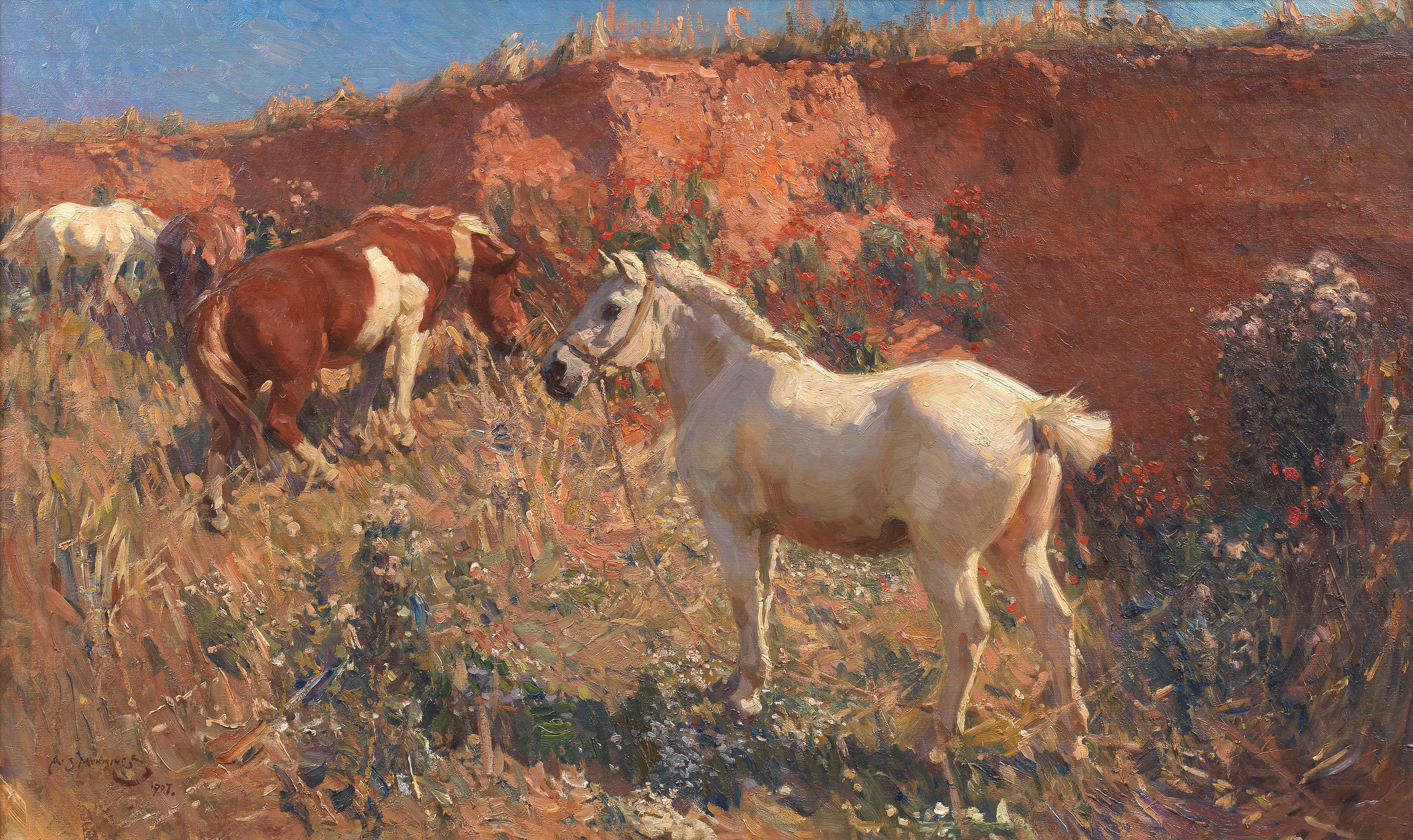

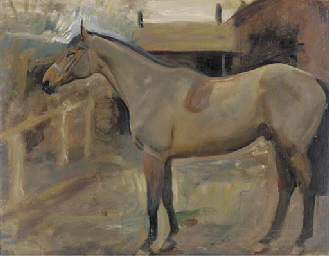
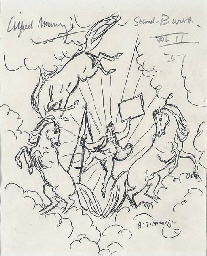
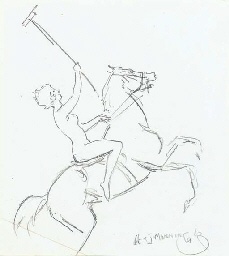
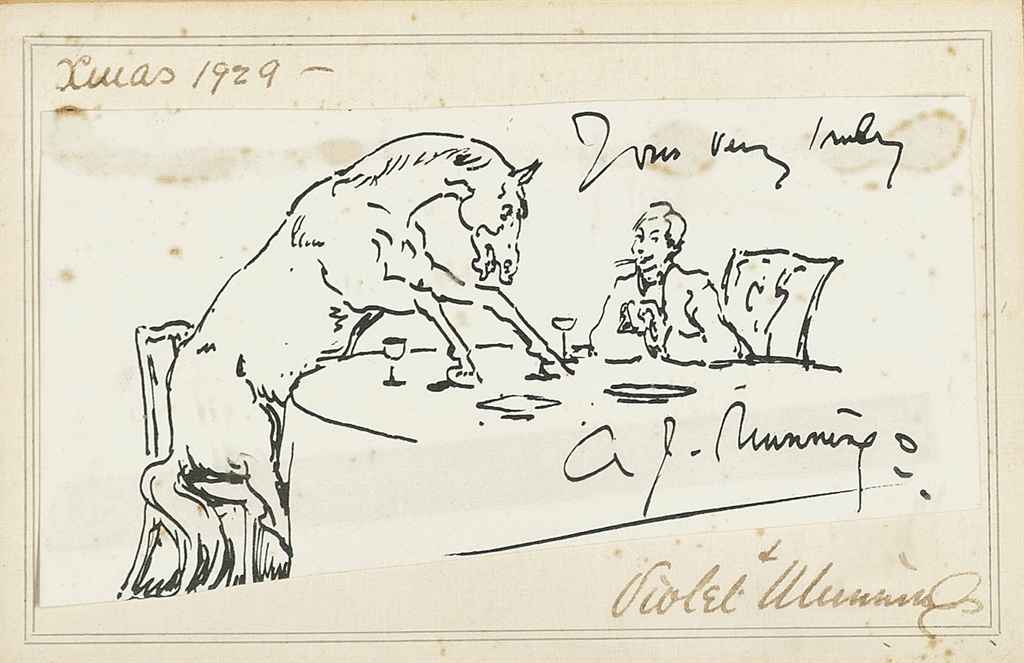

.jpg)

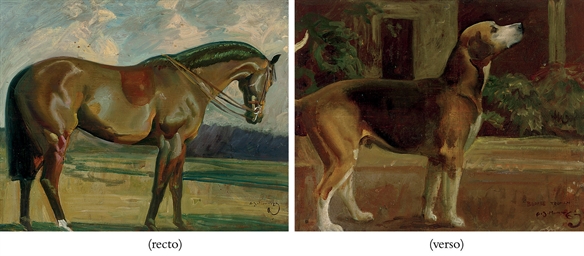
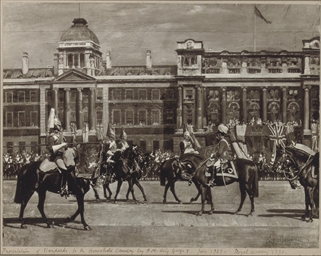
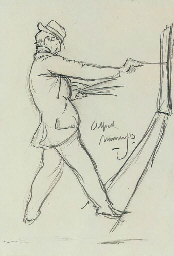
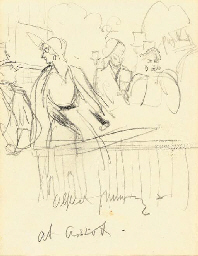
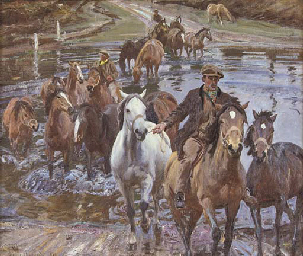
Try LotSearch and its premium features for 7 days - without any costs!
Be notified automatically about new items in upcoming auctions.
Create an alert